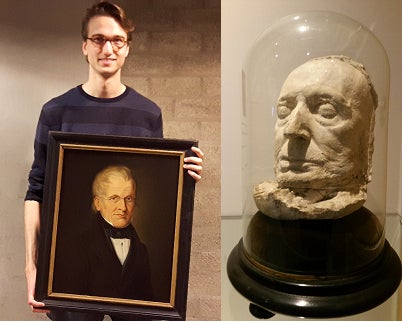Why the death mask and not a painting or book?
'Historians usually work with written sources and images. We can very rarely get to history directly, rarely have a real historical sensation. There is a gap to bridge between past and present. A death mask does that in a very beautiful way, especially if there are still traces of his eyebrows.
Who was Bilderdijk?
'Willem Bilderdijk (1756 - 1831) was a historian, linguist, poet and lawyer, and he could also draw and etch quite well. From an early age he was plagued by melancholy and longing for death. He received prizes for his poetry in 1776, but settled in The Hague as a lawyer in 1882. After the French occupation - during which he first had to flee the country, but later returned as a private tutor to Louis Napoleon - he taught patriotic history in Leiden from 1817. As a result, he exerted great political and religious influence. He gathered around him a group of young men who were later important in the so-called Réveil, an international revival in the Christian world at the beginning of the 19th century. This is the tradition in which Abraham Kuyper also placed himself and VU Amsterdam.'
What is your fascination with Bilderdijk?
'He is a very versatile and interesting historical figure, who made a great contribution to the development of Dutch history. And especially to the idea of a Christian, Protestant history. Besides writing, he also painted, as we just saw in the depot: there's a small painting by his hand. Bilderdijk has actually been completely forgotten. This may be because we don't find the early 19th century as exciting as the Golden Age - but rather bourgeois and boring. Now we think that the 17th century underlies the ideas and values of the Netherlands, but the 18th and 19th centuries were just as important.'
A good poetic citizen
'Willem Bilderdijk was bourgeois, but in the good sense of the word, not petty bourgeois. He was a Dutch, well-to-do citizen, an all-rounder. He also ties in with my research into thinking about the Flood, Paradise, and the downfall of the first world. In the 17th century this was looked at very technically, scientifically: how would it work with the water? The biblical element is then abandoned a bit, one looks more to nature, which is considered the other book that God created. Bilderdijk's poem 'The Decline of the First World' deals with the same themes, but is again very poetic.'
Due to the fragility of the death mask, an image of it with guest curator is unfortunately not possible. The photo therefore shows the guest curator with a portrait of Willem Bilderdijk
